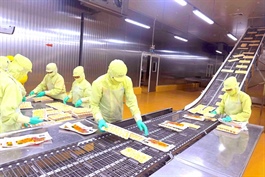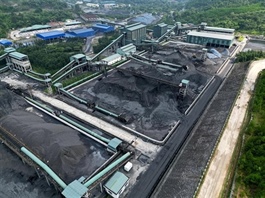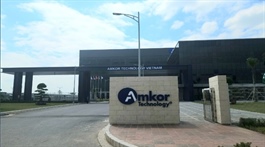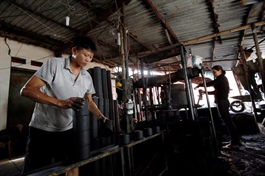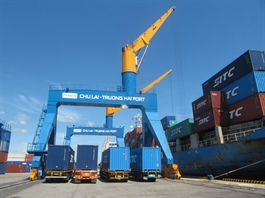Vietnam can enhance its semiconductor advantage
Vietnam can enhance its semiconductor advantage
Thanks to favourable government policies, Vietnam is emerging as an attractive destination for semiconductor manufacturers. Minister of Planning and Investment Nguyen Chi Dung spoke with VIR’s Nguyen Huong about this vision.
Many businesses are planning to invest in electronic component manufacturing factories in Vietnam. Is this the result of government policies and incentives?
|
Minister of Planning and Investment Nguyen Chi Dung |
In the semiconductor industry, Vietnam has almost 180 foreign-led projects with a total registered capital of nearly $12 billion. Vietnam has initially built a semiconductor ecosystem with full stages in the value chain, focusing mainly on two main areas of chip design, and outsourced semiconductor assembly and test.
The design stage includes about 40 enterprises, mostly from Japan, the United States, China, and South Korea such as Qorvo, Renesas, Nvidia, Synopsys, and Marvell. The semiconductor assembly, testing and packaging stage has the presence of leading corporations with large initiatives, such as Intel ($4.1 billion), Amkor ($1.6 billion), Hana Micron ($673 million), and Hayward Quartz Technology ($110 million).
These are outcomes of mobilising investment and encouraging the semiconductor industry in Vietnam. Many legal regulations have been reviewed and proposed to be amended and supplemented to create favourable policies. Therefore, the microchip is listed in prioritised high-tech products.
The Law on Capital City and the resolutions on piloting specific policies for the development of cities such as Ho Chi Minh City and the central city of Danang have included projects in the semiconductor integrated circuit industry, integrated electronic microchips, and chips, as priority areas for attracting strategic investors. A month ago, an investment support fund was established. The fund will support high-tech companies, firms with high-tech products, businesses with high-tech applications, and those with research and development (R&D) centre investments.
Amid a trend of diversifying supply chains and complex geopolitical developments, corporations in the semiconductor industry have been relocating to Asia to set up factories. Vietnam has advantages in developing this, such as high-quality personnel at competitive costs, strong investment and upgrading of infrastructure, and open and transparent policies.
How has the Ministry of Planning and Investment (MPI) facilitated domestic and foreign enterprises to invest in the semiconductor industry?
The prime minister has issued the strategy for the development of Vietnam’s semiconductor industry to 2030 and a vision for 2050, to become a global hub of the semiconductor and electronics hub. In the 2040-2050 period, Vietnam will be in the world’s leading group in semiconductors and electronics, mastering R&D in semiconductors and the electronics sector.
Projects in the semiconductor industry have applied the highest incentives in Vietnam. For example, a 5 per cent corporate income tax rate for 37 years, a six-year corporate income tax exemption, a 50 per cent reduction for the next 13 years; an exemption from land and water surface rent for 22 years and a 75 per cent reduction for the remaining period. The programme on developing personnel also sets the goal to provide at least 50,000 engineers involved in semiconductors.
To welcome the investment wave, Vietnam has approved the Power Development Plan VIII and sped up its implementation; provided clean land in industrial parks and economic zones; and improved transportation, electricity, and water infrastructure to connect industrial ecosystems and reduce production costs. To support investment and business procedures, semiconductor projects invested in the country will be supported by an interdisciplinary working group.
The country’s National Innovation Centre (NIC) has been working with numerous leading partners in semiconductors to establish R&D centres for semiconductor chip design, as well as teaming with more than 30 large international and domestic universities and research institutes on human resource training schemes.
How will the MPI help to train at least 50,000 engineers for the semiconductor industry by 2030?
The ministry has established a working group led by the minister and members from other ministries, agencies, localities, research institutes, universities, organisations, and related enterprises.
The MPI has urged priority to construct, upgrade, and modernise semiconductor laboratories. The scheme will prioritise upgrading and modernisation of four national shared semiconductor laboratories at the NIC, Hanoi National University, Ho Chi Minh City National University, and in Danang for the training of staff across the country.
The NIC is meanwhile working with US technology partners and corporations such as Nvidia, Meta, Qualcomm, Cadence, Marvell, ARM, and Qorvo to boost cooperation on training in the semiconductor industry in Vietnam.
The MPI integrates technology cooperation, especially in key areas such as semiconductors and AI in high-level and all-level foreign affairs activities with the US, India, and South Korea, in addition to international cooperation with partners from the US, South Korea, Japan, and Taiwan.
The ministry has been supporting and encouraging the world’s leading technology corporations to move their supply chains or expand investment, business, and production in Vietnam.
In particular, the signing of a cooperation agreement between Nvidia and the Vietnamese government last December has had great resonance and raised Vietnam’s position in the region and the world as a destination for high technology, semiconductor technology, and AI. The agreement is an important push for Vietnam to make a technological leap forward, especially in AI and semiconductors.
For over five years, the NIC has provided much support to Vietnamese startups. What is its role in proposing favourable policies for technology and innovation enterprises?
The NIC has left some marks in encouraging the innovation ecosystem and supporting startups. The centre has played a role in connecting components in the innovation ecosystem, helping hundreds of large and small enterprises in digital transformation, as well as connecting investment capital and markets.
Moreover, it advocates for policies to create better conditions for startups to develop. Improving and training skills for the workforce has contributed significantly to the sustainable development of the innovation ecosystem.
The centre will continue to accompany startups and innovation enterprises with practical activities. We will build a dynamic innovation ecosystem to create a favourable environment for enterprises to maximise their potential. The NIC will contribute to improving facilities in R&D centres, laboratories, and housing areas for experts to international standards.
The centre is encouraging the development of nine key technology industries: smart manufacturing, smart cities, digital content, cybersecurity, environmental technology, medical technology, semiconductor industry, green hydrogen, and AI.
With abundant human potential and the right strategy, I believe that NIC will be a major hotbed of innovation, enabling Vietnam to be a destination for innovation both regionally and worldwide.







